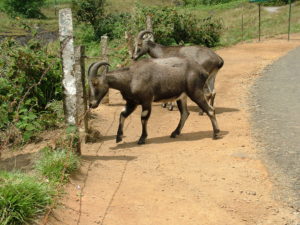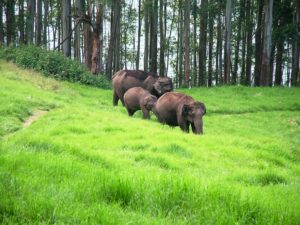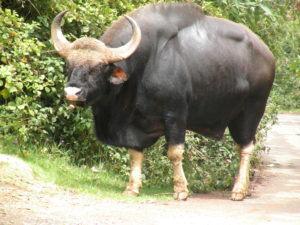Western Ghats
The Western Ghats is a biodiversity hotspot in India and considered on of the eight ‘hottest hot spots’ in the world. It comprises six different states (Goa, Gujarat, Maharashtra, Kerala, Karnataka, and Tamil Nadu), within which includes 52 districts and stretches over 1500km with a break only for 30 km at the Palghat Gap.
What makes this natural stretch considered a biodiversity hotspot (of which there are 25 in the world) is the fact it has a unique and rich assemblage of flora and fauna. For instance, there are hundreds of endemic species in the Western Ghats, meaning these species are found nowhere else in the world, not even the other parts of India. The Western Ghats also plays a crucial role in the both the biophysical and ecological processes within the entirety of the peninsular part of India. When the monsoons start rolling in the Western Ghats act as a barrier and intercept the rain-laden storms, thereby mediating the tropical climate.
With regards to plants, the Western Ghats have been described by Hooker in 1904 as the ‘Malabar’ floristic region. This is partly due to the fact that the Western Ghats has a wide variety of ecosystems: dry deciduous forest, shola forest, evergreen forest, scrub jungles, peat bogs, savannas, and Myristica swamps. The swamp, specifically, is a special kind of fresh water swamp in which an endemic palm is found. There are over 4500 species of plants, of which 1,700 of this species are endemic and one third of the total plants in the Western Ghats are considered rare or threatened.
The fauna diversity is also incredibly impressive within the Western Ghats, having thousands of different animal species. There are more than 117 species of amphibians, of which 78% are endemic; and there are about 590 species of birds, 16 of which are endemic. Other percentages of endemism among vertebrates include: mammals (12%), reptiles (62%), and fish (53%). Some examples of the mammals that are endemic are: the Lion-tailed macaque, Nilgiri Langur, Rusty Spotted Cat, and the Slender Loris. At least 325 of those animals and flora are threatened species, many of which are endemic, especially in regards to the amphibians and reptiles. The Western Ghats is home to some of the largest population of globally threatened species such as the Asian Elephant, Gaur, and Tiger. Given that a large number of vulnerable and valuable species depend on the Western Ghats, it is imperative to protect and sustain it.
The Western Ghats is also an important water source that accounts for most of the rivers (2 major examples being the Godavari and Cauvery Rivers) supplying water to towns and cities and is a critical source of oxygen for the atmosphere. Beyond indirectly supporting numerous communities outside its bounds with resources, it is home to many different indigenous people groups. Again, another reason why this biodiversity hotspot of India needs to be conserved and protected. Deforestation is a huge detriment to the wildlife and people living within the Western Ghats but it is also a cause for concern for those living in urban settings.
For further information refer to the UNESCO website
Nilgiri Biosphere Reserve
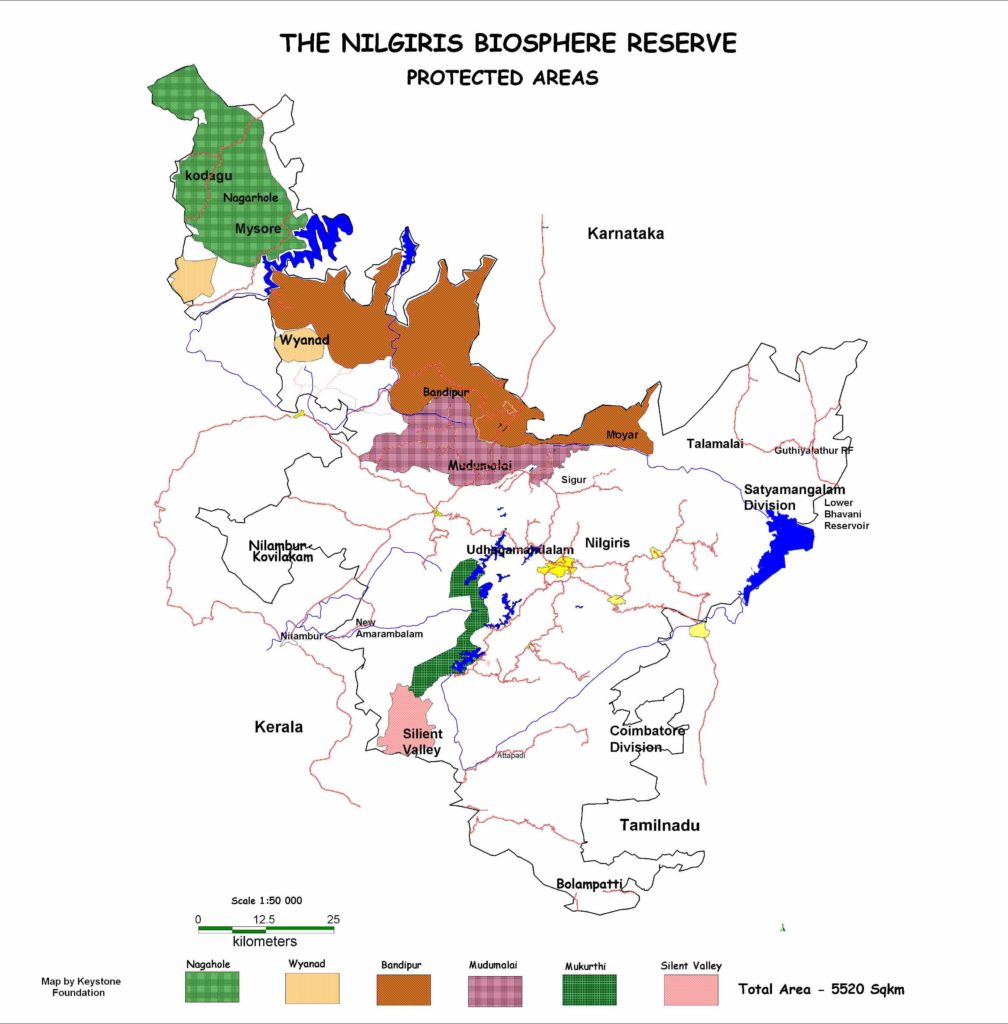
The Nilgiri Biosphere Reserve is found within the Western Ghats and comprises 2 out of 10 of the biogeographical provinces within India. It was established in 1986 as the first biosphere of India. The objectives for why the Nilgiri Biosphere Reserve was established was to: “to conserve insitu genetic diversity of species, restore degraded ecosystems to their natural conditions, provide baseline data for ecological and environmental research and education, [and] to function as an alternate model for sustainable development”(C.P.R Environmental Education Center). Within the Western Ghats there are 285 endemic species and 55% (156) of those are exclusively found within the Nilgiri Biosphere Reserve. This place is so critical in terms of wildlife and diversity that 70% of the NBR is under the protected area status, specifically as national parks, wildlife sanctuaries, and tiger reserves.
This Reserve takes up a total area of 5,520 square kilometers within three states, being: Tamil Nadu (2,573.6 sq. km), Kerala (1455.4 sq. km.), and Karnataka (1527.4 sq. km.). It receives around 500-7000mm of annual rainfall and has a temperature ranges at about 0°C in the winter and as high as 41°C during the summer. In addition, the NBR is found within the Malabar rain forest and is comprised of these protected areas: The Mudumalai Wildlife Sanctuary, Nagarhole National Park, Wyanaad Wildlife Sanctuary Bandipur National Park, Silent Valley, and Mukurthi National Park.
In terms of vegetation, the NBR still has many areas that have gone untampered and the diversity of ecosystems include evergreen forests and dry scrub as well as swamps. Due to the climatic gradients and altitude the different ecosystems are well supported and nourished. There are several different vegetation types and they are described as follows: Moist evergreen ecosystems are dense and are comprised of multiple stories with gigantic trees. They are found within the narrow valleys of Silent Valley. Then there is the Semi Evergreen ecosystem that is also moist and deciduous, and is most commonly found within the Nilambur and Palghat division. Another vegetation type is called Thorn; it is dense and found mainly within the North easterly area of the Nilgiri district. Additionally, there is the Savannah Woodland, found in Mudumalai and Bandipur, which is comprised of trees dispersed amidst woodland. Finally there are the Shola forests and grasslands that are found in the south and western catchment area of the NBR, such as Mukurthi national park. These forests are considered to be evergreens at high elevation in conjunction with grasslands.
Specifics on the various regions of the Nilgiris Biosphere Reserve:
- Nilgiris
- Lies in the North-western part of the Tamil Nadu
- Has both semi-tropical and deciduous forests
- Gudalur Plateau
- Has severe steep slopes
- Has dry deciduous and tropical semi-evergreen forests
- Tea plantations common
- Mudumalai Forested Hills
- Borders Karnataka state and is declared a wildlife sanctuary, especially for elephants
- Tropical evergreen forests
- Sigur Forested Hills
- This is where the eastern and western Ghats meet
- Deciduous forests in this region
- Is highly exploited due to abundance of NTFPs
- Ootacamund Plateau
- Largely filled with tea plantations
- Area fragile to landslides due to all the plantations
- Mostly comprised of the Badagas, an agriculture community
- Kunda Forested Hills
- This region is completely a basin
- Several tree plantations
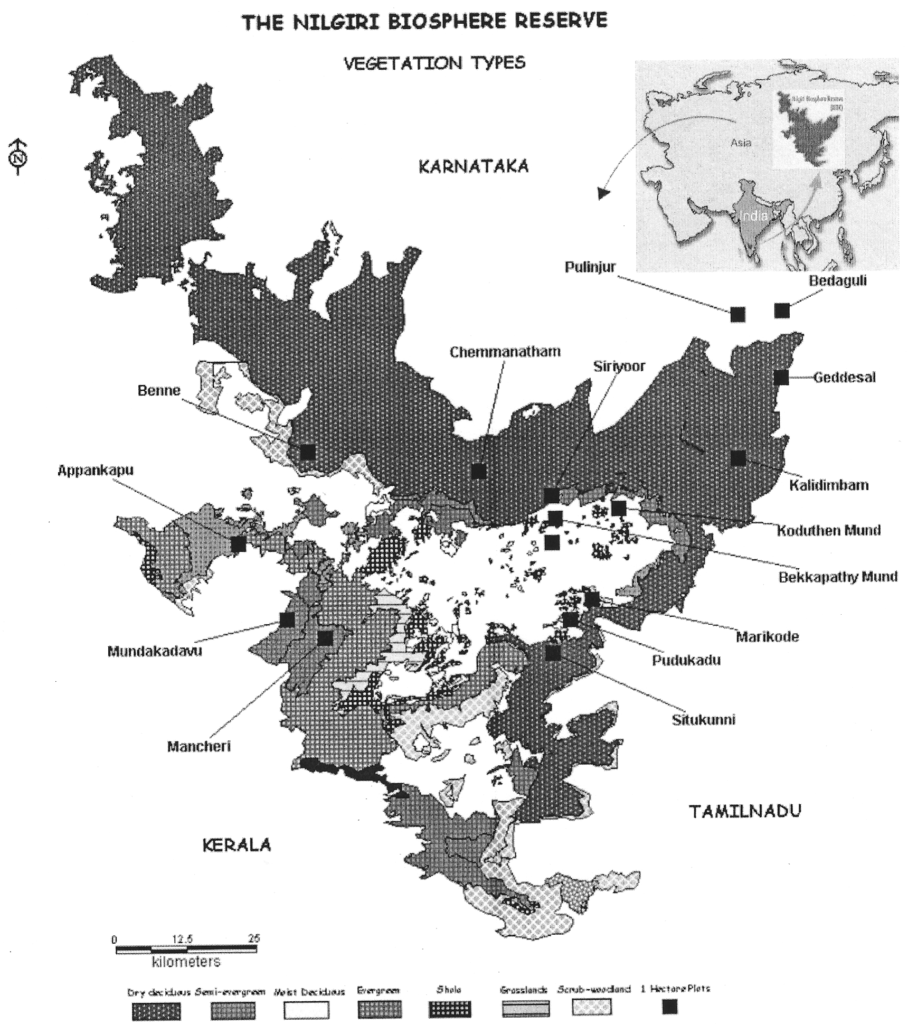
The Nilgiris is very diverse in terms of plants, having 3,300 species of flowering plants, and 132 of which are endemic. For example, the entire genus of Baeolepis is exclusive to the Nilgiris and there are 175 orchid species of which 8 are endemic. More specifically in n terms of plant types there are 3,228 angiosperms (flowering plants), 71 gymnosperms (exposed seed plants), and 134 pteridophytes (ferns). There are also endangered plants within the NBR that include Vanda, Spiranthes, and more. Furthermore, the Shola vegetation of NBR is an invaluable ecosystem that is full of rare plant species. Hence, by the sheer focus of plants, the Nilgiris is a crucial hub of wildlife diversity and endemism.
In addition to plants, the NBR has an incredible fauna diversity, specifically with: 100 species of mammals, 350 birds, 80 of reptiles and amphibians (many of which are endemic to the Western Ghats), 300 species of butterflies and invertebrates, and 39 species of fish. Some of the fresh water fish, like Danio neilgheriensis, and Puntius bovanius, are restricted to the Nilgiri Biosphere Reserve.
Besides the fact that the Nilgiris Biosphere Reserve is a major natural epicenter for diverse ecosystems and wildlife, it also encompasses the Nilgiri district, which is a critical watershed. Within the Nilgiri are the two principal rivers called the Bhavani and the Moyar. It is also estimated that there are more than 30 indigenous groups of the Nilgiri Biosphere Reserve who partake in honey hunting and/or gather other types of NTFPs (non-timber forest products), hence rely heavily on the forested environments. Yet, with all the significance of the NBR, there is still a great deal of fragmentation taking place due to land use changes. Efforts are being made, such as through the Nilgiri Natural History Society, to combat the excessive degradation by educating the public on the importance of conservation and how natural resources can be used in a sustainable way. The Nilgiri Biosphere Reserve is a critical hub and support system for wildlife, indigenous communities, and other surrounding communities. As is represented by the NNHS and other groups, the Nilgiri Biosphere Reserve must be treated with the utmost respect and regard.

